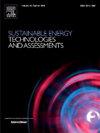Long-term techno-economic analysis considering system strength and reliability shortfalls of electric vehicle-to-grid-systems installations integrated with renewable energy generators using hybrid GRU-classical optimization method
IF 7.1
2区 工程技术
Q1 ENERGY & FUELS
Sustainable Energy Technologies and Assessments
Pub Date : 2025-04-01
DOI:10.1016/j.seta.2025.104294
引用次数: 0
Abstract
Higher penetration of Electric Vehicle-to-Grid charging stations (EV2GCSs) in power grids integrated with renewable energy generators (REGs) result in system-instabilities raising the risk of blackout issues. Although techno-economic feasibility of EV2GCSs has been identified within the literature addressing power outage and financial concerns as a contemporary solution, no long-term techno-economic analysis has been investigated considering system strength and reliability shortfalls before the EV2GCSs installation. Therefore, this research aims to evaluate the long-term (2025–2045) techno-economic analysis of EV2GCSs into REGs-integrated grid systems by accounting for system strength and reliability factors. A novel optimization framework is developed, combining Gated Recurrent Units (GRU) and classical optimization method to achieve optimal size and location of EV2GCSs. The GRU model predicts the energy usage of the EV2GCSs, which is further applied in the classical optimization model to achieve optimal results that analyze long-term techno-economic performance. The obtained results are compared with the existing optimization approaches and non-optimal scenarios, where the proposed research showed that net present value and net profit values can be improved by 19.62% and 13.85% respectively, using the developed optimization framework. Results also show that the system strength level and system reliability can be enhanced approximately 11.829% and 8.671% respectively.
考虑系统强度和可靠性不足的电动汽车与可再生能源发电机组并网系统的混合优化长期技术经济分析
在与可再生能源发电机(REGs)集成的电网中,电动汽车到电网充电站(EV2GCSs)的渗透率越来越高,导致系统不稳定,增加了停电问题的风险。虽然ev2gcs的技术经济可行性已经在文献中被确定为解决停电和财务问题的当代解决方案,但在ev2gcs安装之前,考虑到系统强度和可靠性不足,没有进行长期的技术经济分析。因此,本研究旨在通过考虑系统强度和可靠性因素,评估ev2gcs进入regs集成电网系统的长期(2025-2045)技术经济分析。提出了一种新的优化框架,将门控循环单元(GRU)与经典优化方法相结合,实现了ev2gcs的最优大小和最优位置。GRU模型预测了ev2gcs的能源使用情况,并将其进一步应用于经典优化模型,以获得分析长期技术经济性能的最优结果。将所得结果与现有优化方法和非最优情景进行比较,研究结果表明,采用所开发的优化框架,净现值和净利润分别可提高19.62%和13.85%。系统强度水平和可靠性分别提高了11.829%和8.671%。
本文章由计算机程序翻译,如有差异,请以英文原文为准。
求助全文
约1分钟内获得全文
求助全文
来源期刊

Sustainable Energy Technologies and Assessments
Energy-Renewable Energy, Sustainability and the Environment
CiteScore
12.70
自引率
12.50%
发文量
1091
期刊介绍:
Encouraging a transition to a sustainable energy future is imperative for our world. Technologies that enable this shift in various sectors like transportation, heating, and power systems are of utmost importance. Sustainable Energy Technologies and Assessments welcomes papers focusing on a range of aspects and levels of technological advancements in energy generation and utilization. The aim is to reduce the negative environmental impact associated with energy production and consumption, spanning from laboratory experiments to real-world applications in the commercial sector.
 求助内容:
求助内容: 应助结果提醒方式:
应助结果提醒方式:


